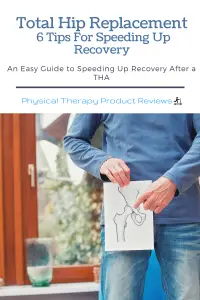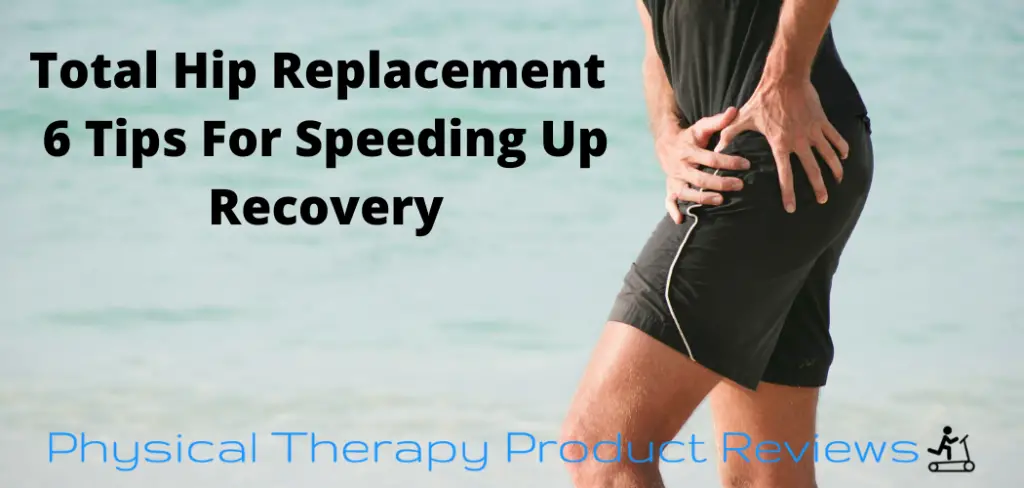A Total Hip Replacement is a procedure that has been done for decades to relieve end-stage arthritis hip pain in patients. A total hip replacement is an invasive surgery that replaces the head of the Femur and the “Socket” of the Acetabulum with new metal alloys to relieve pain from bone-on-bone wear and tear.
 Due to the invasiveness of the surgery, recovery after a total hip replacement does take time and focused effort. There is pain from the surgery, swelling, reduced strength, and stiffness for months after surgery. However, with a few specific tips, you can speed up the recovery and get back to your daily activities easier. Years after your surgery you may even look back and say to yourself, “ That wasn’t that bad.”
Due to the invasiveness of the surgery, recovery after a total hip replacement does take time and focused effort. There is pain from the surgery, swelling, reduced strength, and stiffness for months after surgery. However, with a few specific tips, you can speed up the recovery and get back to your daily activities easier. Years after your surgery you may even look back and say to yourself, “ That wasn’t that bad.”
How to Recover Faster After a Total Hip Replacement
Recovery after a total hip replacement can feel like it takes forever, but in reality, it’s quite a marvel how fast you can return to walking and squatting after such a major surgery. Some people fly through recovery, while others struggle to make progress weekly. We see a few common traits as healthcare providers in patients that recover faster than others.
These include:
- Doing exercises before surgery.
- Walking as much as possible
- Working on glute and hip strength
- Staying in motion and avoiding being sedentary
- Taking the steps maintain overall health with sleep and proper nutrition
Do Exercises Before Your Hip Replacement
One of the best ways to speed up recovery after a hip replacement is to do physical therapy exercises before surgery. Exercises before surgery, also called Pre-hab, have been shown to have better outcomes, faster strength gains, and lower pain levels than for patients who did not do exercises before surgery.
This makes sense though, the more motion and strength you have before surgery, the more you will have after surgery, and the easier the recovery will be.
We recommend strengthening the glutes and the quads for prehab exercises and improving your hip range of motion. These muscles will help to speed up the stability and control of the hip after surgery. These muscles are crucial for walking after total hip replacement surgery.

To improve your range of motion, focus on stretching your hip flexor muscles to enhance your hip extension motion. After surgery, the hip flexors will become tight to protect the new surgery and from sitting more often. This also may help reduce back pain that can occur after surgery.
Some of our favorite exercises to do before a total hip replacement include:
- Bridges
- 3-way Hip with a Band
- Monster Walks
- Squats
- Lateral Step-ups
Walk as Often as You Can After Surgery and Walk Backward
After a total hip replacement, it is important to try and walk as often as your body will let you without flaring up the pain. Walking helps improve range of motion, helps increase blood flow to the joint, builds muscle, and reduces muscle tightness. Walking also helps pump the swelling out of the muscles and out of the joint.
Start by doing short walks around the house at 2-5 minutes in length of time. It’s better to walk multiple times a day instead of 1 long walk of 30 minutes. Try and walk at least 5-6x a day for 5 minutes in the time immediately after surgery. You can slowly progress each week to longer and fewer walks as you start to feel improvement.
Another helpful tip to speed up recovery is to practice periods of backward walking. Walking backward helps improve limping after surgery, stretches out the front of the hip and hip flexors, and improves glute strength and activation.
Start by walking backward at the kitchen counter so you have something you can hold on to for balance and slowly progress for longer walks in the hallway or living room.
Emphasize Glute Strength After Your Hip Replacement
After total hip replacement, it is imperative to try and build up muscle strength in your glute muscles. The more you can activate the glutes, the more stable and supported the hip joint will be. The glute muscles control your stability during walking, stairs, and squatting. It’s essential to target not only the glute max but also the glute abductors.

Plus, it’s extremely common for the glute muscles to be weak going into the surgery. Most people have had years of weakness building up in their hip muscles because it’s been painful.
Some exercises we recommend for strengthening after a total hip replacement include:
- Clams
- Standing hip Abduction
- Glute Bridges
- Monster Walks
- Squats
- Lateral Step-ups
Stay Active and Moving at all Times After Surgery
It is important to stay as active as possible after surgery. The more you move the hip through the day the less stiffness you’ll feel and the less swollen the joint will be. If you find yourself sitting in one spot for longer than 30 minutes at a time then you need to get up, move, and change positions. Our bodies are meant to be in motion and don’t do well with being sedentary.
Sitting allows for stiffness to increase and swelling to pool in the joint. You’ll feel the worst after longer periods of sitting.
You can get up and walk to the bathroom, fridge, or even stand up and do some mini squats to loosen up the hip. You can also take your dog on longer walks or check the mail. Schedule your mini activities to keep you active. It’s better to be slightly too physically active than too sedentary after surgery.
We also love the idea of getting a home exercise bike or a recumbent elliptical after a total hip replacement. It’s a safe and easy way to exercise the muscles and build up strength without having to go to the gym.
Take Care of Your Body With Sleep and Proper Nutrition
One of the most important things for total hip replacement recovery is to ensure that you get proper sleep and nutrition. Sleep helps with healing, reduces pain medication needed, and increases your energy throughout the day. Getting good sleep allows your body to repair itself during rest.
It can be hard to sleep after a hip replacement, so be sure to use a pillow between the knees, ice, or use heat right before bed, and feel free to use a topical pain cream that help you stay asleep.
Your diet should be balanced nutrition to help you heal faster. Think about it, would a cheeseburger provide your new hip surgery with more nutrients or fruits and vegetables? Your body will be craving good quality protein, lots of vegetables, and even more importantly, staying hydrated with a good water intake.
How Long Does it Take to Recover from a Hip Replacement
It takes roughly a full year to completely recover from a total hip replacement. However, most people will feel 75% or greater of normal only 3 months after surgery. This all depends on your overall health, how compliant you are with your home exercise program, and how focused you are on recovery.
If you don’t take recovery seriously or you get lazy with your exercises it might take quite a bit longer to feel normal and get back to your regular activities.
How Soon After a Hip Replacement Surgery Before you can Walk
You can walk with a walker on the same day of surgery. The faster you get up and walk the better the hip will feel. You’ll need a walker or other assistive device to walk for the first 2-3 weeks after surgery.
You will be limited to short walks in your home and around the yard until you get off all narcotic pain medications and the walker.
You’ll quickly notice that the more often you walk the better your hip feels. Even though there is pain and swelling, your body is telling you that you need to get up and walk.
How Long Do You Use a Walker After a Hip Replacement?
If you get total hip replacement surgery, you will likely have a walker for the first two to three weeks. This is not always the case, and sometimes people can transition to using a cane sooner or even use a walker longer up to 4 weeks after surgery.
We recommend using a walker until you can walk without a limp, there is minimal pain with walking, and your gait mechanics are close to being back to normal.
Do You Use a Cane After a Hip Replacement?
Yes, after a total hip replacement, it’s likely that you will have a walker for the first two to three weeks and then transition to using a cane for a short period of time. This is typically from 2 days to a full 7 days of using the cane after the walker.
Using a cane is an excellent way to walk with less pain, be cautious of falling after a hip replacement, and protect yourself from others, such as in the grocery store.
Some people may not use the cane after surgery and go straight from discharging the walker to walking without any assistive device.
Conclusion
After total hip replacement surgery, there are a few tips that can help speed up recovery. It can sometimes feel like recovering from a hip replacement can take a long time, but with a few simple tips and overall focus, it will go by faster than you realize. It’s important to focus on your recovery so that your hip fully heals and doesn’t limit you in the future.
How to Stay Active After Cervical Fractures: Expert Tips and Advice
Dealing with Painful Stairs After Ankle Replacement Surgery
Walking After a Total Ankle Replacement: Tips for a Successful Recovery
Exercises While Non-Weight Bearing After Ankle Replacement: Elevation, AROM, Leg Raises, and More
Ankle Pain with Stairs: Causes and Home Treatment Options
5 Common Mistakes You’re Making After an Ankle Sprain
Disclaimer: The information provided in this post is for educational purposes only. This is not a substitute for a medical appointment. Please refer to your physician before starting any exercise program.







